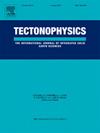Locating active faults in the Cusco Valley using magnetotelluric and radon gas data
IF 2.7
3区 地球科学
Q2 GEOCHEMISTRY & GEOPHYSICS
引用次数: 0
Abstract
This study presents a novel approach to identifying and characterizing active faults in urban areas, using an example from the city of Cusco in Peru, by combining magnetotelluric (MT) exploration and radon gas monitoring. The research aims to improve understanding of the active faults in the Cusco Valley by using the MT method to provide subsurface electrical resistivity data, enabling the mapping of fault structures and determination of fault properties. A 2-D inversion of the MT data resulted in resistivity models that revealed critical information about fault geometry, such as dip and depth. Radon gas measurements complement the MT data by being able to distinguish between active and inactive faults. This is because active faults can exhibit higher permeability due to ongoing tectonic activity. This increased permeability facilitates the migration of radon from deeper rock formations to the surface, leading to detectable anomalies. Active faults are particularly significant as their continued deformation enhances permeability, making radon anomalies a valuable indicator for locating these structures. A clear correlation was found between elevated radon concentrations (>5.9 kBq m−3) and the locations of faults identified through the MT resistivity model, and additional gas sample analyses ruled out the possibility that these anomalies were caused by lithological variations. This integrated approach holds significant potential for detecting active faults in urban areas such as Cusco. In these locations faults such as the Cusco and Alto Qosqo faults may be obscured by construction. The findings uncovered previously unmapped fault lineaments and advanced the understanding of fault kinematics in Cusco, emphasizing the importance of combining MT and radon monitoring for earthquake hazard assessment in urban environments.
求助全文
约1分钟内获得全文
求助全文
来源期刊

Tectonophysics
地学-地球化学与地球物理
CiteScore
4.90
自引率
6.90%
发文量
300
审稿时长
6 months
期刊介绍:
The prime focus of Tectonophysics will be high-impact original research and reviews in the fields of kinematics, structure, composition, and dynamics of the solid arth at all scales. Tectonophysics particularly encourages submission of papers based on the integration of a multitude of geophysical, geological, geochemical, geodynamic, and geotectonic methods
 求助内容:
求助内容: 应助结果提醒方式:
应助结果提醒方式:


